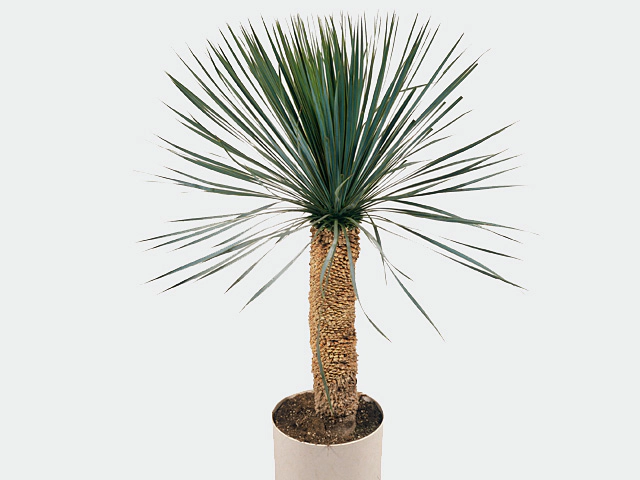Yucca rostrata

| Leaf arrangement | wreath, in a rosette |
| Leaf tip | Pointed/acute |
| Leaf base | Perfoliate |
| Leaf margin | Dentate |
| Leaf type | Foliage leaf |
| Winter hardness | Reasonable (USDA-zone 7) |
| Leaf, general shape | Linear |
| Structure (tissues) | Woody |
| Leaf width | 0 - 1 cm |
| Leaf surface | Glaucous |
| Leaf duration | Evergreen |
| Leaf size | 30 - 40 cm |
| Light conditions | Sunny |
| Leaf division | Simple |
| Leaf, main color | Green grey |
| Leaf colour, pattern | Marginate |
| Leaf, secondary color(s) | Yellow |
| Moisture requirements | Dry; Well-drained |
Yucca rostrata, also known as Yucca or Palmlilie, is a striking plant that adds a touch of elegance to any garden or landscape. This article will provide a detailed description of the Yucca rostrata based on its leaf arrangement, tip, base, margin, type, winter hardness, general shape, structure, width, surface, duration, size, light conditions, division, main color, color pattern, secondary color, and moisture requirements.
The leaf arrangement of Yucca rostrata is wreath-like, forming a beautiful rosette. The leaves have pointed or acute tips and a perfoliate base, meaning the leaf wraps around the stem, creating the appearance of a perforation. The leaf margins are dentate, with small teeth along the edges, giving it a unique texture.
Yucca rostrata has foliage leaves, which means its primary purpose is to provide photosynthesis for the plant. Its leaves are reasonably hardy in winter, suitable for USDA zone 7. The general shape of the leaves is linear, resembling long, slender blades. The tissues of the leaves are woody, providing stability and strength to the plant.
The width of Yucca rostrata's leaves ranges from 0 to 1 cm, making them thin and delicate. The leaf surface is glaucous, which gives them a waxy appearance, protecting them from excessive moisture loss. These leaves are evergreen, ensuring that the plant retains its vibrant appearance throughout the year. The size of the leaves is approximately 30 to 40 cm, making them substantial and visually appealing.
Yucca rostrata thrives in sunny conditions, requiring ample sunlight to grow and flourish. The leaves are simple, meaning they are undivided and do not have separate leaflets. The main color of the leaves is a pleasant green-grey, giving them a sophisticated and natural look. The color pattern of the leaves is marginate, indicating that the edges have a contrasting color to the rest of the leaf. In the case of Yucca rostrata, the margins are yellow, adding a vibrant touch to the plant's overall appearance.
Moisture-wise, Yucca rostrata prefers dry conditions and well-drained soil. It is essential to avoid overwatering the plant, as it is adapted to arid environments. Providing proper drainage and allowing the soil to dry out between watering will ensure the plant's health and longevity.
In conclusion, Yucca rostrata is a captivating plant with its wreath-like leaf arrangement, pointed tips, perfoliate base, dentate margins, foliage leaf type, reasonable winter hardness, linear shape, woody structure, glaucous surface, evergreen duration, substantial size, preference for sunny conditions, simple division, green-grey main color, marginate color pattern with yellow margins, and dry, well-drained moisture requirements. Adding Yucca rostrata to your garden or landscape will undoubtedly bring a touch of beauty and uniqueness to your outdoor space.
Market availability index by month:
| Jan. | Feb. | Mar. | Apr. | May | Jun. | Jul. | Aug. | Sep. | Oct. | Nov. | Dec. |
|---|---|---|---|---|---|---|---|---|---|---|---|
| 4 | 3 | 3 | 3 | 4 | 3 | 3 | 3 | 3 | 3 | 3 | 3 |